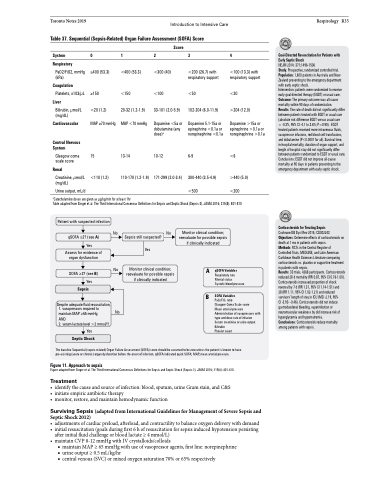Page 1281 - TNFlipTest
P. 1281
Toronto Notes 2019 Introduction to Intensive Care Table 37. Sequential (Sepsis-Related) Organ Failure Assessment (SOFA) Score
Respirology R35
Goal-Directed Resuscitation for Patients with Early Septic Shock
NEJM 2014: 371;1496-1506
Study: Prospective, randomized controlled trial. Population: 1,600 patients in Australia and New Zealand presenting to the emergency department with early septic shock.
Intervention: patients were randomized to receive early goal-directed therapy (EGDT) or usual care. Outcome: The primary outcome was all-cause mortality within 90 days of randomization.
Results: The rate of death did not significantly differ between patients treated with EGDT or usual care (absolute risk difference EGDT versus usual care =-0.3%,95%CI-4.1to3.6%;P=0.90). EGDT treated patients received more intravenous fluids, vasopressor infusions, red blood cell transfusions, and dobutamine (P<0.0001 for all). Survival time, in-hospital mortality, duration of organ support, and length of hospital stay did not significantly differ between patients randomized to EGDT or usual care. Conclusions: EGDT did not improve all-cause mortality at 90 days in patients presenting to the emergency department with early septic shock.
Corticosteroids for Treating Sepsis
Cochrane DB Syst Rev 2015; CD002243 Objectives: Determine effects of corticosteroids on death at 1 mo in patients with sepsis.
Methods: RCTs in the Central Register of
Controlled Trials, MEDLINE, and Latin American Caribbean Health Sciences Literature comparing corticosteroids vs. placebo or supportive treatment in patients with sepsis.
Results: 33 trials, 4268 participants. Corticosteroids reduced 28 d mortality (RR 0.87, 95% CI 0.76-1.00). Corticosteroids increased proportion of shock reversal by 7 d (RR 1.31, 95% CI 1.14-1.51) and
28 (RR 1.11, 95% CI 1.02-1.21) and reduced survivors’ length of stay in ICU (MD -2.19, 95% CI-3.93--0.46).Corticosteroidsdidnotinduce gastroduodenal bleeding, superinfection or neuromuscular weakness by did increase risk of hyperglycemia and hypernatremia.
Conclusions: Corticosteroids reduce mortality among patients with sepsis.
System
Respiratory
PaO2/FiO2, mmHg (kPa)
Coagulation
Platelets, x103/μL
Liver
Bilirubin, μmol/L (mg/dL)
Cardiovascular
Central Nervous System
Glasgow coma scale score
Renal
Creatinine, μmol/L (mg/dL)
Urine output, mL/d
0
≥400 (53.3) ≥150
<20 (1.2)
MAP ≥70 mmHg
15
<110 (1.2)
1
<400 (53.3)
<150
20-32 (1.2-1.9) MAP <70 mmHg
13-14
110-170 (1.2-1.9)
Score
33-101 (2.0-5.9)
Dopamine <5a or dobutamine (any dose)a
10-12
171-299 (2.0-3.4)
2
<300 (40)
<100
3
<200 (26.7) with respiratory support
<50
102-204 (6.0-11.9)
Dopamine 5.1-15a or epinephrine <0.1a or norepinephrine <0.1a
6-9
300-440 (3.5-4.9) <500
4
<100 (13.3) with respiratory support
<20
>204 (12.0)
Dopamine >15a or epinephrine >0.1a or norepinephrine >0.1a
<6
>440 (5.0) <200
aCatecholamine doses are given as μg/kg/min for at least 1hr
Table adapted from Singer et al. The Third International Consensus Definitions for Sepsis and Septic Shock (Sepsis-3). JAMA 2016; 315(8): 801-810
Patient with suspected infection
qSOFA ≥2? (see A) Yes
Assess for evidence of organ dysfunction
SOFA ≥2? (see B) Yes
Sepsis
Despite adequate fluid resuscitation, 1. vasopressors required to maintain MAP ≥65 mmHg
AND
2. serum lactate level >2 mmol/l? Yes
Septic Shock
No
No
No
No
Monitor clinical condition; reevaluate for possible sepsis if clinically indicated
Monitor clinical condition; reevaluate for possible sepsis if clinically indicated
Sepsis still suspected? Yes
A B
qSOFA Variables
Respiratory rate Mental status
Systolic blood pressure
SOFA Variables
Pa02/FiO2 ratio
Glasgow Coma Scale score
Mean arterial pressure Administration of vasopressors with type and dose rate of infusion Serum creatinine or urine output Bilirubin
Platelet count
The baseline Sequential (sepsis-related) Organ Failure Assessment (SOFA) score should be assumed to be zero unless the patient is known to have pre-existing (acute or chronic) organ dysfunction before the onset of infection. qSOFA indicated quick SOFA; MAP, mean arterial pressure.
Figure 11. Approach to sepsis
Figure adapted from Singer et al. The Third International Consensus Definitions for Sepsis and Septic Shock (Sepsis-3). JAMA 2016; 315(8): 801-810.
Treatment
• identifythecauseandsourceofinfection:blood,sputum,urineGramstain,andC&S • initiateempiricantibiotictherapy
• monitor,restore,andmaintainhemodynamicfunction
Surviving Sepsis (adapted from International Guidelines for Management of Severe Sepsis and Septic Shock 2012)
• adjustmentsofcardiacpreload,afterload,andcontractilitytobalanceoxygendeliverywithdemand
• initialresuscitation(goalsduringfirst6hofresuscitationforsepsisinducedhypotensionpersisting
after initial fluid challenge or blood lactate ≥ 4 mmol/L)
• maintainCVP8-12mmHgwithIVcrystalloids/colloids
■ maintain MAP ≥ 65 mmHg with use of vasopressor agents, first line: norepinephrine ■ urine output ≥ 0.5 mL/kg/hr
■ central venous (SVC) or mixed oxygen saturation 70% or 65% respectively


